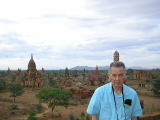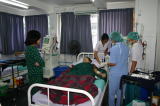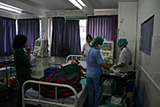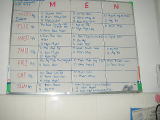Observation report
Hideo Hidai's Whirlwind Myanmar Travelogue. May 27, 2007
Military-ruled Myanmar (Burma) is internationally isolated and its economic situation, healthcare conditions, and so on are very obscure. Even in the studies on RRT (renal replacement therapy) conducted by all the Fresenius Group in the country, the numbers of dialysis patients and transplant patients are also unclear, like in Cambodia and Laos of the Indochinese Peninsula which have been targeted by our NGO, UBPI.
 So, during the second half of my holiday, from May 3rd to 7th, I took advantage of a 5-day sightseeing tour in order to observe the state of RRT in Myanmar.
So, during the second half of my holiday, from May 3rd to 7th, I took advantage of a 5-day sightseeing tour in order to observe the state of RRT in Myanmar.
I found out online that a “5-day tour of Bagan, Myanmar”, planned by an excursion company well acquainted with the area, was still available even for just one traveller. So, unaware that May was Myanmar’s rainy season (with average humidity of 80%) and terribly hot for travellers (with temperatures up to 40°C), I booked my ticket.
For one thing, in military-ruled Myanmar, I thought it would be difficult to get a visa if the purpose of my visit was other than sightseeing. Furthermore, I had already visited two of the world’s three great Buddhist temple ruins at Angkor Wat and Borobudur (my parents were devout Buddhists) and wanted to visit the third one, the Bagan ruins.
While looking for an expert on Myanmar, I was introduced by clinical engineer Mr. Okamoto to Noriyoshi Iwasaki of Nipro’s international sales division, who in turn recommended Mr. Komaru, president of Myanmar Yutani Co., Ltd., Nipro’s agent in Yangon.
Mr. Komaru is a man of good faith who has good relations with doctors and the military authorities, and it is thanks to him that my visit to Myanmar was a success.
In addition to Mr. Okamoto’s connections, I also sent a fax to the Medical Attache of the Embassy of Japan in Myanmar, Mr. Nyui, with whom I had not the slightest acquaintance, asking for an introduction to someone knowledgeable about dialysis. I was thrilled when Mr. Nyui introduced me almost immediately to dialysis physician Dr. Thwin.
My solo tour itinerary included the sightseeing around the Yangon city after returning from Bagan on the Saturday, so I asked a big favor to cancel the sightseeing and visited the Kidney Center at the private Bahosi General Hospital thanks to the efforts of Mr. Komaru. (Although called a Kidney Center, it has only 3 beds, carrying out dialysis twice a week, 4 hours per time, in 3 shifts of morning, afternoon and night, from Monday to Saturday or Sunday.)
The dialysis room was clean and the water treatment equipment including ion-exchange resin and reverse-osmosis devices all rivaled those used in Japan. The room was virtually operated by the nurses.

 Later, I had dinner at my hotel together with Professor Htay, Head of the Nephrology Department at Yangon General Hospital, Dr. Thwin, Mr. Komaru and his General Manager
(who spoke perfect Japanese, had graduated from a science university and was therefore even more knowledgeable than a clinical engineer, and was in charge of maintenance).
I found out various things about RRT, such as the fact that dialysis had already been carried out in Myanmar since 1990, and that 36 patients received living-donor kidney transplants from related donors.
Later, I had dinner at my hotel together with Professor Htay, Head of the Nephrology Department at Yangon General Hospital, Dr. Thwin, Mr. Komaru and his General Manager
(who spoke perfect Japanese, had graduated from a science university and was therefore even more knowledgeable than a clinical engineer, and was in charge of maintenance).
I found out various things about RRT, such as the fact that dialysis had already been carried out in Myanmar since 1990, and that 36 patients received living-donor kidney transplants from related donors.
I also learned that even with 3 shifts a day, 7 days a week, patients could undergo dialysis only twice a week due to the lack of machines.
Not only that, only those rich enough or those high up in the military and their families to afford a high dialysis cost for one session could receive dialysis treatments.
 At the time, there were 350 dialysis patients, but considering a population of 43 million, that number represented only 8.1 people out of every million, about one third of that in Vietnam (24 people out of every million). Of course neither country can be compared with Japan (2,000 people out of every million), but comparing these countries of the Indochinese Peninsula, I realized that Myanmar was in the most urgent need of assistance.
At the time, there were 350 dialysis patients, but considering a population of 43 million, that number represented only 8.1 people out of every million, about one third of that in Vietnam (24 people out of every million). Of course neither country can be compared with Japan (2,000 people out of every million), but comparing these countries of the Indochinese Peninsula, I realized that Myanmar was in the most urgent need of assistance.
Luck was really with me during this trip to Myanmar, with light cloud and temperatures between 28°C and 30°C at the Bagan ruins, and later in Yangon, I never got caught in the rain heavy enough to open an umbrella.
Bagan is the largest of the world’s three great Buddhist temple ruins, and I wish I had had at least a week just to walk around gazing at the remaining 4,000 to 5,000 temples and a forest of pagodas scattered across the truly vast plain.
I took a boat onto the Ayeyarwady (Irrawaddy) River, where I switched off the engine and just drifted with the current, and as I gazed at the pagodas on both banks and watched the people bathing in the twilight, thoughts came to my mind of the tens of thousands of Japanese soldiers overrun and slaughtered by British armored divisions at nearby Mandalay and Myitkyina.
Hideo Hidai
Ubiquitous Blood Purification International (UBPI)
